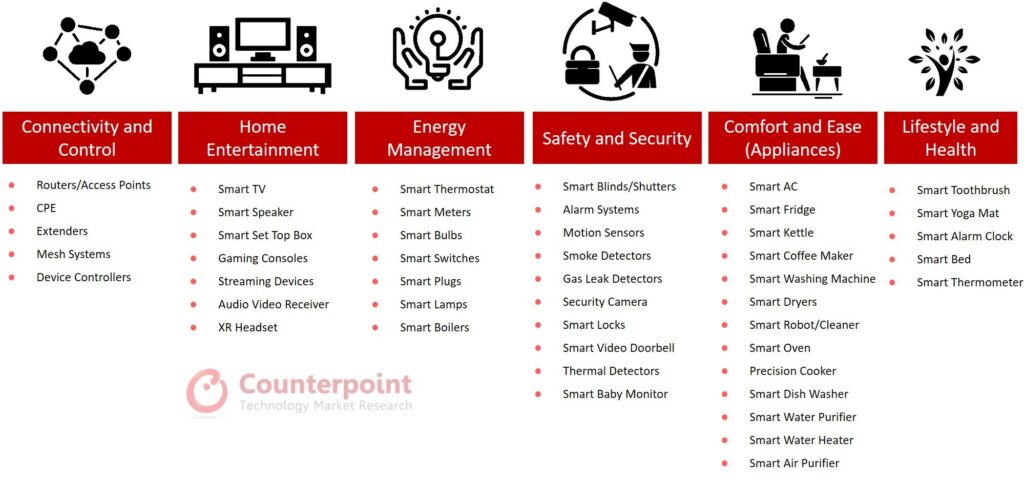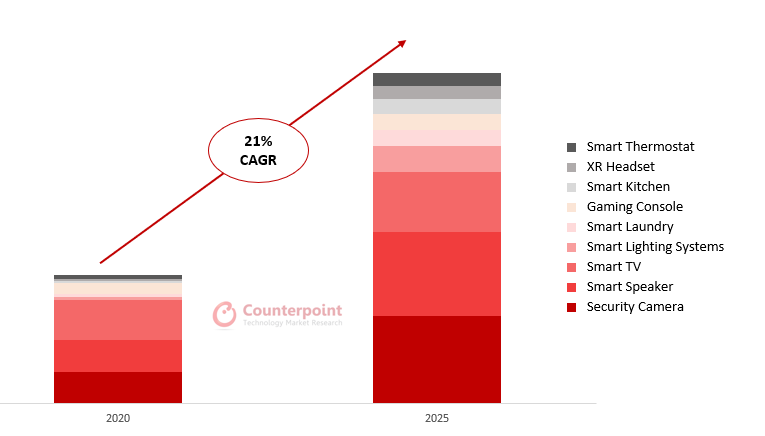- The shipments of WiFi-based smart home devices are estimated to grow at a CAGR of 21% between 2020 and 2025.
- Smart television, security camera and smart speaker will be the major categories driving this market.
- A wide variety of applications are driving the growth of this market, providing immense opportunities to many players across the value chain.
Over the past few years, there has been a surge in consumer awareness regarding the importance and benefits of using smart devices at home. A smart home is defined as a home where appliances can communicate with one another and can be controlled remotely from anywhere through an internet connection. The smart home market is growing rapidly due to the changing needs of customers, demand for greater comfort and security, recent advancements in technology, introduction of innovative products, and rising investments in this field. The COVID-19 pandemic has also provided the necessary boost to this segment, as consumers are spending more time at home and looking for home entertainment solutions and devices that can offer an increased level of automation.
Smart home market growth and applications driving it
The smart home market is quite fragmented with various products being introduced in all the emerging application areas. Each of these product categories has its own growth path and is supported by different wireless protocols like Wi-Fi, Bluetooth, Zigbee and Zwave. Among these, there is a great potential for Wi-Fi-based devices to grow due to their better connectivity, which is needed to operate the current smart homes effectively. Counterpoint has identified certain product categories in the smart home market which are more important in terms of growth and customer adoption. These product categories are smart speakers, smart TV, security camera, smart thermostat, smart lighting, smart kitchen (including smart fridge, smart dishwasher and smart oven), smart laundry (including smart washing machine and dryer), XR headsets and gaming consoles.
Exhibit 1: Main Smart Home Applications and Products
 Source: Counterpoint Research Global Smart Home Market Report, 2021
Source: Counterpoint Research Global Smart Home Market Report, 2021
We estimate that the shipments of such Wi-Fi-based devices will grow at a CAGR of 21% between 2020 and 2025. There are a wide variety of applications that are driving the growth of this market, such as home entertainment, energy management, safety and security, lifestyle and health, and smart appliances.
Exhibit 2: Global Smart Home Device Shipments (Key Categories )

Source: Counterpoint Research Global Smart Home Market Report, 2021
Major trends in market
- Devices supporting digital assistants: Voice control is no longer confined to smart speaker devices. Digital assistants are increasingly becoming integrated into multiple home devices. This has led to greater consumer adoption. For instance, realme Smart Plug comes with Google and Alexa support. Similarly, we have thermostats (Ecobee), smart locks (August), and routers (Netgear) supporting digital assistants.
- Wi-Fi 6 gaining popularity: Wi-Fi 6 chipsets and modules are now being installed in emerging smart home devices. For instance, Samsung’s latest 8K QLED TV is the world’s first TV to feature Wi-Fi 6 with a Mediatek chipset. Besides, we have seen routers from Netgear, Xiaomi, Linkys, TP-Link and D-Link supporting Wi-Fi 6.
- Touch displays as user interface: Smart displays are primarily smart speakers with a display attached to them. Smart displays will act as the primary user interface, a central hub to control all other smart home devices like lights, TVs, fans, security cameras and door locks.
- Introduction of Wi-Fi mesh systems: With the increasing number of smart home devices, having one Wi-Fi point in the house is no longer good enough. To be able to run more devices simultaneously, wider coverage is needed. Therefore, Wi-Fi mesh systems are increasingly becoming popular, as they help get rid of the internet dead zones or dead spots to provide seamless wireless coverage. Various brands like Netgear, TP-Link, Linksys and D-Link are launching Wi-Fi mesh systems to expand their portfolio beyond traditional routers.
- New ways of monetization: Traditionally, we have seen brands offering a subscription model in which customers are required to pay a fee for a constant value. However, now companies are increasingly looking to identify new ways to monetize smart home technology, like service bundling, launching audio ads and using IoT data.
Emerging opportunities
- Shift from devices to services: As device margins are fading away slowly, in the coming period, from a brand perspective, the focus will be more on the stickiness factor by offering innovative solutions and value-added services to customers on top of the device sale.
- Role of advertising: Advertising will have a central role in smart homes. Advertisers will acquire vast amounts of consumer data and use advanced AI or ML algorithms to serve relevant, customized ads to users at appropriate times.
- Offline retail is critical: Retailers can play a vital role in smart home adoption by launching consumer experience zones. This can be accompanied by promotional discounts, targeted marketing campaigns, and device bundling offers. For instance, Amazon provides a bundling offer of Echo speakers with Philips Hue bulb.
- Connected lifestyle experience: Device makers have an opportunity to differentiate themselves and broaden their customer base by opening new product categories and expanding their product portfolio to offer a seamless connected lifestyle experience.
- Tracking usage patterns: Businesses can utilize the vast amount of IoT data generated through systems and sensors to track consumer behavior and buying patterns. The data can also be used to improve customer experience and boost sales by offering proactive services like preventive maintenance and sending reminders through emails or calls whenever there is a shortage based on the customer’s usage patterns.
- Content generation and storage: The increasing amount of data generated through smart devices like security camera generates strong demand for remote storage and access. Therefore, there is a growing potential for cloud-based players to enter this market, form partnerships and offer multi-device cloud-based solutions to their customers.
Challenges ahead
- Compatibility: There are several different apps and various protocols which are used to manage and control smart home devices. Therefore, incompatibility is the biggest concern in smart home technology.
- Security and privacy: Nowadays, a smart home collects and transmits data to servers to enable communication between sensors and applications without any user control. This may consist of sensitive personal information depending on the source and application type. To solve the problem posed by this critical privacy risk, there should be a privacy-aware context-sensitive framework that enables users to define privacy preferences for different settings.
- High cost: The price point for certain categories of smart home devices is still very high for mass adoption. Companies need to launch devices that are cost-effective. Amazon and Google have shown some positive movement in this regard.
- Connectivity: Network connectivity is one of the most common issues faced by smart home devices. This can be solved by switching to a better wireless router or a Wi-Fi mesh networking system to have consistent connectivity throughout the home.
The smart home market is still in a nascent stage. However, it is growing rapidly due to both demand- and supply-side push. Wi-Fi is going to be the major driver for growth. Cumulative shipments of Wi-Fi-capable smart home devices from 2020 to 2025 are likely to cross the six-billion mark. This fragmented market represents a billion-dollar opportunity for many players, including component suppliers, device manufacturers, retailers, platform and cloud partners, and telecom companies. The future of the smart home is built on two important factors – seamless integration and network connectivity. In the coming years, we estimate that the use cases will also start evolving to include areas like content consumption and e-commerce.

